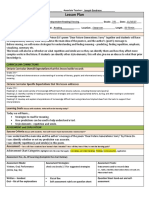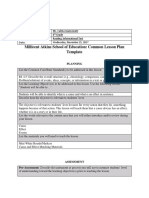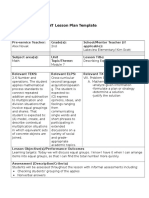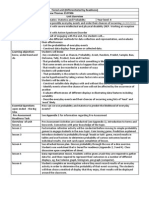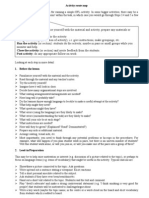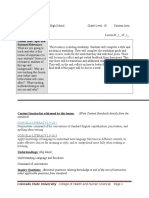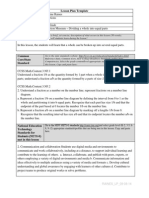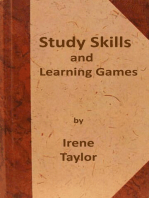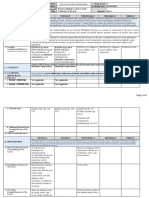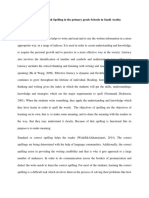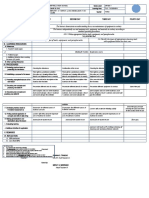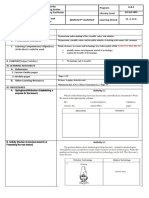Lesson Plan 5
Lesson Plan 5
Uploaded by
api-338809879Copyright:
Available Formats
Lesson Plan 5
Lesson Plan 5
Uploaded by
api-338809879Original Title
Copyright
Available Formats
Share this document
Did you find this document useful?
Is this content inappropriate?
Copyright:
Available Formats
Lesson Plan 5
Lesson Plan 5
Uploaded by
api-338809879Copyright:
Available Formats
Lesson Planning Form for Accessible Instruction Calvin College Education Program
Teacher
Date
Ms. Edison
11/17/16
Subject/ Topic/ Theme
Functions: Scatter Plots and Trend Lines (Day 5)
Grade __9th____
I. Objectives
How does this lesson connect to the unit plan?
This lesson is the fifth section in the chapter, and it focuses on scatter plots and trend lines. The previous section equips students with the ability to graph functions.
Now that they have a solid understanding of graphs, Chapter 3 wants to prepare students to understand and analyze scatter plots, and understanding correlation.
cognitivephysical
socioLearners will be able to:
R U Ap An E developme emotion
C*
nt
al
U, Ap
Graphing a scatter plot from given data
Describing correlations from scatter plots
R, An
Identifying correlations
U, An
Matching scatter plots to situations
U, An, E
Common Core standards (or GLCEs if not available in Common Core) addressed:
CC.9-12.F.LE.5 Interpret the parameters in a linear function in terms of a context.*
CC.9-12.S.ID.6 Represent data on two quantitative variables on a scatter plot, and describe how the variables are related.*
CC.9-12.S.ID.6a Fit a function to the data; use functions fitted to data to solve problems in the context of the data.*
CC.9-12.S.ID.6c Fit a linear function for a scatter plot that suggests a linear association.*
CC.9-12.S.ID.7 Interpret the slope (rate of change) and the intercept (constant term) of a linear model in the context of the data.*
CC.9-12.S.ID.8 Compute and interpret the correlation coefficient of a linear fit.*
CC.9-12.S.ID.9 Distinguish between correlation and causation.*
CC.9-12.S.IC.6 Evaluate reports based on data.*
(Note: Write as many as needed. Indicate taxonomy levels and connections to applicable national or state standards. If an objective applies to particular learners
write the name(s) of the learner(s) to whom it applies.)
*remember, understand, apply, analyze, evaluate, create
II. Before you start
Identify prerequisite
knowledge and skills.
Students need to be familiar with graphs.
Pre-assessment (for learning): Students will take notes from a video of the lesson for section 3.5, and will
complete a Quia quiz online which will check their understanding of relations and functions.
Outline assessment
activities
(applicable to this lesson)
Formative (for learning): As a class, we will go over any confusion on the notes/Quia. I will go through an
example or two with the class.
Formative (as learning): We will go through a partner/all-class activity of a few independent/dependent
situations. The students will work on a maze worksheet on creating and evaluating functions.
Summative (of learning): Going over in class.
What barriers might this
lesson present?
What will it take
neurodevelopmentally,
experientially,
emotionally, etc., for your
students to do this lesson?
9-15-14
Provide Multiple Means of
Representation
Provide options for perceptionmaking information perceptible
A video for the lesson
allows the students to
control their viewing.
Provide Multiple Means of Action
and Expression
Provide options for physical actionincrease options for interaction
Provide options for language,
mathematical expressions, and
symbols- clarify & connect
language
Provide options for expression and
communication- increase medium
of expression
Body movements to
express correlation
Body movements to
express correlation
Provide Multiple Means of
Engagement
Provide options for recruiting
interest- choice, relevance, value,
authenticity, minimize threats
Doing whip movements
to express correlations
Provide options for sustaining effort
and persistence- optimize challenge,
collaboration, mastery-oriented
feedback
Provide options for comprehensionactivate, apply & highlight
Materials-what materials
(books, handouts, etc) do
you need for this lesson
and are they ready to
use?
On their devices, notes,
or smart board.
[everyone has (means
to) a device]
Provide options for executive
functions- coordinate short & long
term goals, monitor progress, and
modify strategies
Provide options for self-regulationexpectations, personal skills and
strategies, self-assessment &
reflection
Students will need a laptop/device, which all students have one or have the means to one. We will need
internet access for the beginning. We will have a smart board to work on review with the students.
These will all be ready to use. The worksheets will be prepared for the students.
The classroom will have the normal row set-up. Each student will have a laptop/device for the
beginning of the class period.
How will your classroom
be set up for this lesson?
III. The Plan
Time
8:42
Components
Motivation
(opening/
introduction/
engagement)
Describe teacher activities
AND
student activities
for each component of the lesson. Include important higher order thinking questions and/or prompts.
Display the Daily Agenda
Pull out notes for us to check.
Prepare a Warmup worksheet for the
Complete the Warmup.
students to complete.
o Graph the function y = -2x 1
o Determine the correlation in the
following situation. (positive,
negative or no correlation)
- The number of
chickenpox vaccines
given and the number of
chickenpox cases
reported.
o The table shows the number of
soft drinks sold at a small
restaurant from 11:00am to
1:00pm. Graph a scatter plot
using the given data, and draw a
trend line.
Check students notes from the video.
Go over any reoccurring questions from
the lessons video, and the Warmup.
o The video lets students interact,
and there is always space to leave
questions.
Take notes on the review/recap
o Engage in review and discussions.
9:09
Display the key for the worksheet they
worked on in the last class.
Check answers and ask questions on
yesterdays worksheet.
9:14
Pass out practice worksheets.
Go through worksheet.
8:49
9-15-14
Development
(the largest
component or
main body of
the lesson)
9:33
Closure
(conclusion,
culmination,
wrap-up)
Walk around and help when needed.
Go over any reoccurring questions from
the worksheet.
Explain what to do with worksheet, and
anything else needed.
If they finish early then they can
watch the video for the next
lesson.
Wrap-up, listen, hold onto the sheet to
finish at home.
Your reflection about the lesson, including evidence(s) of student learning and engagement, as well as ideas for improvement
for next time. (Write this after teaching the lesson, if you had a chance to teach it. If you did not teach this lesson, focus on the
process of preparing the lesson.)
This lesson had to be adapted to include another look at section 3.4, but was also successful in teaching section 3.5 to the
students. Because students were struggling with graphing functions, we had to revisit it in the beginning of this lesson.
Unlike the past four lessons, this warmup was not online so when I was checking notes I could also check to see if the
students were working on it easier than I could with Quia. The problem with not using Quia is that I could not check
who/how many students were getting each problem correct or incorrect. Either way, after about 8 minutes, we went over the
Warmup worksheet together. I regathered attention, waiting for all eyes and ears to be on me, and we went through a
recap/review that had a diverse engagement. In the past lessons, I was often asking questions generally and getting the usual
students to raise their hands, or I was getting answers blurted out. While I could still analyze understanding, it was difficult.
This time, I was calling on students, especially students who looked like their engagement may have been diverted away
from the lesson. By the time we were done with the recap/review, we had engaged in a deep discussion on scatter plots and
trend lines, and I could tell that students were feeling somewhat confident that they could handle the material. I could tell
because there was good engagement from around 80% of the class, I could see a lot of head-nodding, and they were asking
good clarifying questions that showed deeper understanding.
Then we went into reviewing the worksheet from the last lesson and beginning the worksheet for this lesson. I accidently
forgot to go over the worksheet from the last class, originally, and passed out the 3.5 worksheet first. Once I noticed my
mistake, I told the class to look over their 3.4 worksheet first, displaying the answer key on the board. This actually gave the
students a chance to look over the worksheet at their own pace, and begin the 3.5 worksheet if they did not need the amount
of time I was giving them to check their answers. Things went fine, and I answered questions individually because the
questions were quick/diverse. After five minutes, the last of the answer key was on the board, and I began walking around to
help with the 3.5 worksheet when needed. The students were doing well, when they were working on the worksheet, but I did
have to point 4-5 students to do it.
At the end, we went over two of the questions together. The first one went well, and I had 2-3 students participate with the
whole class. The second question did not go as well. I messed up with the labeling, a student pointed out that it should have
been different, and she was right, but I accidentally started redoing the problem when all I needed to do was switch the label.
As a class, we came to the correct answer, but it had to have been very confusing. Overall, this lesson went well, and was
simple for the students to grasp in during the class period.
9-15-14
You might also like
- I. Title: Project: Oplan Msfog Mentoring Student Skills in Four Fundamental Operations and GraphsDocument3 pagesI. Title: Project: Oplan Msfog Mentoring Student Skills in Four Fundamental Operations and GraphsLem Rada96% (57)
- Second Grade Science LessonDocument15 pagesSecond Grade Science Lessonlionheart10131333% (3)
- Employee Post Training Evaluation FormDocument3 pagesEmployee Post Training Evaluation FormD Tech Dental Technologies100% (3)
- Lesson Plan Form Udl Fa14 2Document3 pagesLesson Plan Form Udl Fa14 2api-334861434100% (1)
- Dear Future Generations LessonDocument7 pagesDear Future Generations Lessonapi-392214817No ratings yet
- Curriculum Mapping Major Trends and IssuesDocument20 pagesCurriculum Mapping Major Trends and IssuesMs J100% (1)
- Lesson Plan 2Document3 pagesLesson Plan 2api-338809879No ratings yet
- Lesson Plan 4Document3 pagesLesson Plan 4api-338809879No ratings yet
- Lesson Planning Form For Accessible Instruction - Calvin College Education ProgramDocument4 pagesLesson Planning Form For Accessible Instruction - Calvin College Education Programapi-338809879No ratings yet
- 1-Scoe Lesson Planning Template Fa23 2 1Document5 pages1-Scoe Lesson Planning Template Fa23 2 1api-583052012No ratings yet
- Lesson 1 Plan FormDocument6 pagesLesson 1 Plan Formapi-336528722No ratings yet
- Lesson Planning Form For Accessible Instruction - Calvin College Education ProgramDocument6 pagesLesson Planning Form For Accessible Instruction - Calvin College Education Programapi-336528722No ratings yet
- Ms. Chelsea Decker Lesson Plan/Assessment #3 For The 9: GradeDocument7 pagesMs. Chelsea Decker Lesson Plan/Assessment #3 For The 9: Gradeapi-285000116No ratings yet
- Lesson Planning Form For Accessible Instruction - Calvin College Education ProgramDocument5 pagesLesson Planning Form For Accessible Instruction - Calvin College Education Programapi-336528722No ratings yet
- Direct Instruction Lesson Plan TemplateDocument2 pagesDirect Instruction Lesson Plan Templateacraver4694No ratings yet
- 4math Lesson 10 3Document5 pages4math Lesson 10 3api-236893416No ratings yet
- Educ 302 - Lesson 4Document3 pagesEduc 302 - Lesson 4api-339064965No ratings yet
- Pre-Observation Formkunakorn9oct18Document2 pagesPre-Observation Formkunakorn9oct18api-456126813No ratings yet
- Millicent Atkins School of Education: Common Lesson Plan TemplateDocument7 pagesMillicent Atkins School of Education: Common Lesson Plan Templateapi-332331761No ratings yet
- Recount Lesson Plan-Oct PracticumDocument5 pagesRecount Lesson Plan-Oct Practicumapi-282820976No ratings yet
- Whole Group Lesson Cause and EffectDocument10 pagesWhole Group Lesson Cause and Effectapi-371197391No ratings yet
- Educ 302 - Lesson 3Document3 pagesEduc 302 - Lesson 3api-339064965No ratings yet
- (If Applicable, If Not Explain Why) : (Demonstration of Learning)Document3 pages(If Applicable, If Not Explain Why) : (Demonstration of Learning)api-282904450No ratings yet
- Observation #2 - Math LessonDocument5 pagesObservation #2 - Math LessonAlexandra KeresztesNo ratings yet
- Stepp Review Activity 1Document6 pagesStepp Review Activity 1api-281839323No ratings yet
- Mge MLDP Lesson PlanDocument10 pagesMge MLDP Lesson Planapi-745005042No ratings yet
- Tennis Ball ActivityDocument3 pagesTennis Ball Activityapi-326735709No ratings yet
- Lesson Plan 4Document3 pagesLesson Plan 4api-283599791No ratings yet
- Third Grade Math LessonDocument6 pagesThird Grade Math Lessonapi-591042996No ratings yet
- Unit Lesson Plan-Fact FamiliesDocument3 pagesUnit Lesson Plan-Fact Familiesapi-252532158No ratings yet
- UMF Unit-Wide Lesson Plan Template: Course:EDU 450Document6 pagesUMF Unit-Wide Lesson Plan Template: Course:EDU 450api-397487642No ratings yet
- Math Lesson Plan-PortfolioDocument8 pagesMath Lesson Plan-Portfolioapi-273144496No ratings yet
- UMF Unit-Wide Lesson Plan Template: Course: EDU 460Document6 pagesUMF Unit-Wide Lesson Plan Template: Course: EDU 460api-507844172No ratings yet
- Generalization Lesson Plan Edu505Document10 pagesGeneralization Lesson Plan Edu505api-284836900No ratings yet
- Living Forever Lesson PlanDocument6 pagesLiving Forever Lesson Planapi-425637153No ratings yet
- Lesson Plan 3 Educ 302Document8 pagesLesson Plan 3 Educ 302api-315445685No ratings yet
- National University Lesson Plan Nov9 VDocument5 pagesNational University Lesson Plan Nov9 Vapi-320720255No ratings yet
- Ed 302 Unit Plan Lesson 4 PDFDocument4 pagesEd 302 Unit Plan Lesson 4 PDFapi-300683985No ratings yet
- Lesson Planning Form For Accessible Instruction - Calvin College Education ProgramDocument4 pagesLesson Planning Form For Accessible Instruction - Calvin College Education Programapi-336528722No ratings yet
- ASSURE Model Instructional PlanDocument9 pagesASSURE Model Instructional Planapi-340857409No ratings yet
- Teacher Work SampleDocument12 pagesTeacher Work Sampleapi-444858079No ratings yet
- Solve Real-World ProblemsDocument3 pagesSolve Real-World Problemsapi-545793045No ratings yet
- Week 1 LP 1Document5 pagesWeek 1 LP 1api-281891598No ratings yet
- Lesson Plan 11-20Document2 pagesLesson Plan 11-20api-242063979No ratings yet
- Lesson Plan 2 - D, I, J, VariationDocument2 pagesLesson Plan 2 - D, I, J, VariationJe PascualNo ratings yet
- Lesson Planning Form For Accessible Instruction - Calvin College Education ProgramDocument4 pagesLesson Planning Form For Accessible Instruction - Calvin College Education Programapi-338809879No ratings yet
- Lesson 1 Unit PlanDocument4 pagesLesson 1 Unit Planapi-300384449No ratings yet
- Diversity LessonDocument5 pagesDiversity Lessonapi-254206113No ratings yet
- Photo Scavenger HuntDocument4 pagesPhoto Scavenger HuntBri AnthonyNo ratings yet
- Lesson Plan Template: Essential QuestionDocument6 pagesLesson Plan Template: Essential Questionapi-550336195No ratings yet
- Lesson Plan 6Document3 pagesLesson Plan 6api-300681621No ratings yet
- 4 SRT Lesson e WebbDocument2 pages4 SRT Lesson e Webbapi-346174767No ratings yet
- UNT Lesson Plan Template: Pre-Service Teacher: Grade(s) : School/Mentor Teacher (If Applicable)Document10 pagesUNT Lesson Plan Template: Pre-Service Teacher: Grade(s) : School/Mentor Teacher (If Applicable)api-351959830No ratings yet
- Tiered Lesson Plan and AppendiciesDocument7 pagesTiered Lesson Plan and Appendiciesapi-295583127No ratings yet
- Activity Route MapDocument3 pagesActivity Route MapEva Hatiarová100% (5)
- Lesson Idea/Topic and Rational/Relevance:: CEP Lesson Plan FormDocument8 pagesLesson Idea/Topic and Rational/Relevance:: CEP Lesson Plan Formapi-353478397No ratings yet
- Northern State University Junior Field Teacher Work Sample: DescriptionDocument8 pagesNorthern State University Junior Field Teacher Work Sample: Descriptionapi-300518953No ratings yet
- Lesson Plan Outline: RD THDocument3 pagesLesson Plan Outline: RD THapi-280302368No ratings yet
- Raines Lessonplan 09-08-14Document7 pagesRaines Lessonplan 09-08-14api-268708704No ratings yet
- Tpa 1Document11 pagesTpa 1api-501103450No ratings yet
- Scientific NotationDocument5 pagesScientific NotationJacob TrinkleNo ratings yet
- Informational Text Toolkit: Research-based Strategies for the Common Core StandardsFrom EverandInformational Text Toolkit: Research-based Strategies for the Common Core StandardsNo ratings yet
- Classroom Observation FormDocument2 pagesClassroom Observation FormAnn RoverNo ratings yet
- Mathematics Activity Sheet: Quarter 2 - MELC 12Document6 pagesMathematics Activity Sheet: Quarter 2 - MELC 12Jean Marie Ga Lacson0% (1)
- Lesson 7Document9 pagesLesson 7Alyza Cassandra MoralesNo ratings yet
- Get Creating High Performance Teams Applied Strategies and Tools for Managers and Team Members 1st Edition Ray Aldag free all chaptersDocument81 pagesGet Creating High Performance Teams Applied Strategies and Tools for Managers and Team Members 1st Edition Ray Aldag free all chaptersbdssfaisca100% (1)
- DRRM ModuleDocument35 pagesDRRM ModuleVeronika MartinNo ratings yet
- Lesson Plan For EAPPDocument1 pageLesson Plan For EAPPCris VillarbaNo ratings yet
- Dokumen To SMAN 1 BekasiDocument9 pagesDokumen To SMAN 1 BekasiRoro Ayu MarwinniNo ratings yet
- Interview LPDocument3 pagesInterview LPluckylotus13No ratings yet
- New DDL Week 6 - July 24-28Document4 pagesNew DDL Week 6 - July 24-28Josenia ConstantinoNo ratings yet
- English Spelling Lit ReviewDocument22 pagesEnglish Spelling Lit ReviewMadeeha Syed100% (1)
- DLL Tle 7 Cookery Q3W3Document2 pagesDLL Tle 7 Cookery Q3W3romar ipac100% (1)
- 08 J1 201700012 PDFDocument17 pages08 J1 201700012 PDFgraciacallisseNo ratings yet
- Activity 4Document2 pagesActivity 4BONILITA CORDITANo ratings yet
- BTEC 2020 L3 INT Sport SOW U26 V1Document12 pagesBTEC 2020 L3 INT Sport SOW U26 V1faith.mutanuNo ratings yet
- Learning Standards Tests: Unit 1 TestDocument5 pagesLearning Standards Tests: Unit 1 TestCaulfield HoldenNo ratings yet
- ALS LS 2 - Technology and Its BenefitsDocument4 pagesALS LS 2 - Technology and Its Benefitsカイ リートNo ratings yet
- AR Sample Part 2Document23 pagesAR Sample Part 2Dlanor RonaldNo ratings yet
- We Are Not The VirusDocument8 pagesWe Are Not The VirusJudie Faith LeonidaNo ratings yet
- Lesson Plan in Food and Beverage ServicingDocument5 pagesLesson Plan in Food and Beverage ServicingCicille Grace Alajeño CayabyabNo ratings yet
- Detailed Lesson Plan in English 315Document6 pagesDetailed Lesson Plan in English 315joaquiconradtoscanoNo ratings yet
- 202346Document74 pages202346MichNo ratings yet
- Reflection. On PortfolioDocument1 pageReflection. On PortfolioMarjhun Flores Guingayan0% (1)
- Design Thinking ProcessDocument14 pagesDesign Thinking ProcessPatrica LybbNo ratings yet
- Language Acquisition and MarkednessDocument13 pagesLanguage Acquisition and Markednesssubramani muthusamyNo ratings yet
- SITXHRM001 Assessment V 1.0 1Document22 pagesSITXHRM001 Assessment V 1.0 1shulusha khadkaNo ratings yet
- Class Program 2024 2025Document12 pagesClass Program 2024 2025corine rongcalNo ratings yet
- Bihar School Examination Board, PatnaDocument1 pageBihar School Examination Board, PatnaVikas kumarNo ratings yet




